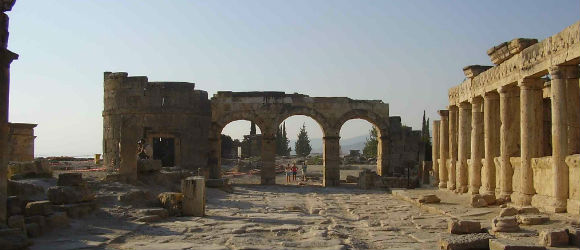The presence of a hot spring at Hierapolis and the spectacular calcium deposits from its water spilling over the nearby hillside suggest that there should be evidence of an early settlement there. The oldest Inscription found so far, however, indicates it was founded by Eumenes II, king of Pergamon, in the latter part of the second century B.C.; it soon became a busy industrial center.
Pagan worship in the city centered around Cybele, Apollo, Artemis, Men, Poseidon, and Pluto. Underneath the Temple of Apollo has been found the Plutonium, an opening in the earth from which a noxious gas still comes. The temple is between the pool where the hot spring rises and the large theater on the side of the hill. To the north along the rim of the plateau is a long avenue of tombs.
Traditionally St. Philip is connected with the early church in Hierapolis. Fairly recently Italian archeologlsts have discovered his Martyrium, an octagonal chamber forming a double cross surrounded by a square. This is almost due north of the theater, also on the side of the hill. It was a fifth century A.D. building and did not last much more than 100 years. No tomb was found with it although that was expected. There are several ruins of churches, one not far from the baths, one on the main road leading to the necropolis.
Hierapolis is listed in the New Testament along with Laodicea as the center of Epaphras’s work (Colos-sians 4:13). This was at the time Paul was writing to strengthen the message Epaphras was preaching and to condemn the “people who go in for self-mortification and angel-worship” (Colossians 2:18). Another less well-known resident of Hierapolis was Papias, a disciple of St. John and the author of the lost book called the Sayings of Jesus.
While Epaphras was is that area, a young slave was growing up in Hierapolis, a boy whose original name is unknown but whom we call by the Greek for “Acquired”, Epictetus. In his Discourses Epictetus often talks about the perfect missionary whose bed was the ground, whose only house the earth and sky and a shabby cloak, and who must love those who misuse him in the service of God. One wonders what the influence of those early Christians, many of whom were slaves themselves, was on this Stoic philosopher.
Hierapolis,


Definitely worth visiting, Best to try to get there around 10am to have few hours there, a very good idea to start from the top to walk all the way down enjoying the pools on the way.
Do not go with the organised tour, It's better to go there on it's own so there is no rush.Enjoy.
While Ephesus gets all the publicity on most websites, Hierapolis is a real gem – just not hyped about enough – which may work to your advantage since it is less crowded and thus makes it easier for you to travel back in time.
We arrived at Pamukkale from Capadoccia at about 5 in the morning. We stayed at a…
From the parking lot you have to walk 10 minutes to the attraction. The shop near the parking lot sells souvenirs at affordable price, although you'll get lower price at the bazzaar.
White as snow, this hilly calcium area is walkable. Put your shoes on the entrance, then walk along the site. In summer (june) it's 38 DEGC and more….
Absolutely amazing. If we didn't give ourselves enough time to really take everything in -a Turkish local friend said we needed only 3-4 hours, but we spent about 6 hours there and it still wasn't enough for us. We could have spent many more hours poking around the ruins of Hierapolis, and hours lazing around the antique pool and more…
Great stadium, roman city, walk on enourmous grounds, thru the ancient city, graves and over looking the famous thermal blue water and startling white cliffs,
We took a tour to Turkey in 2009 and one day we went to Pamukkale and Hierapolis. What an amazing site to see the cascade of white, calcium carbonate rock formations with the water flowing over them! We were allowed to wade out into a few of the pools, but found that the rock was fairly rough. Interesting experience along…
Pamukkale is a magical place and be sure to spend a lot of time there. The experience is quite surreal with ice blue water pools on a pure white mountain side. Its a unique, magical place and a must visit for anyone travelling to Turkey. A word of caution: its really far from any of the more established towns like…
Blown away by the mineral baths. You have to see them to truly appreciate the beauty.
Avoid the "Ancient Pool", crowded and expensive.
The necropolis at Hierapolis is outstanding as well.
Make sure to check out the partially buried crypt overlooking the valley. The mineral salts have built up around it making for a wonderful photo-op.
Pamukkale translates to Cotton Castle in English. We got here on a Director Tour organised in Bodrum. Long day (15hrs from pickup to drop off) but well worth it. The Hierapolis ruins were interesting, the swim in Cleopatra's Bath was fun and seeing the network of saucer shaped travertines cascading down the white calcified mountain was amazing. Agree with other…